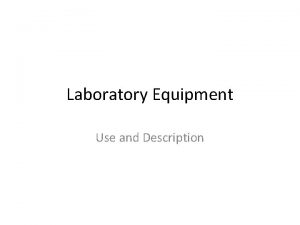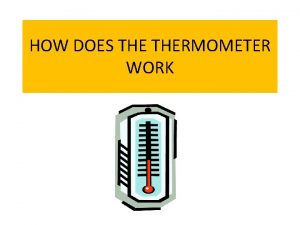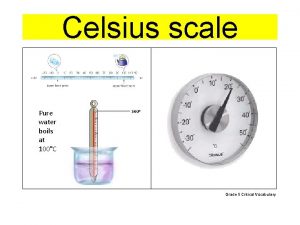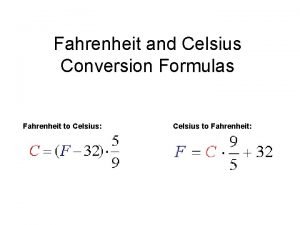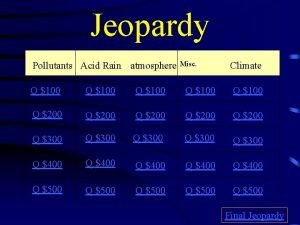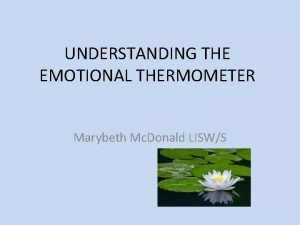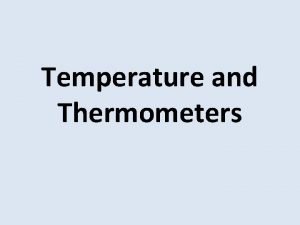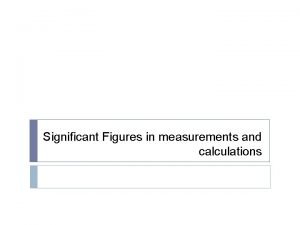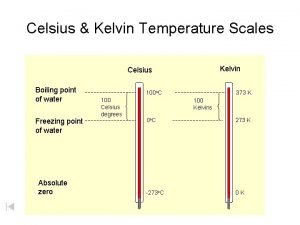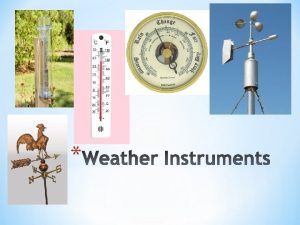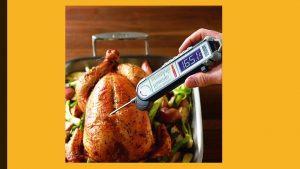Temperature Celsius Scale How does a thermometer work













- Slides: 13

Temperature

Celsius Scale •


How does a thermometer work? • Particle theory • We know that the particles in a gas are more spread out than the particles in a liquid. As liquids increase in T/E, the particles begin speed up and to spread out even before they become a gas. • The more the particles spread out, the more volume they take up. The forces the liquid in thermometer to take more space and move up thermometer.

Acidity and Alkalinity

Acidity and Alkalinity • ALL liquids may be classified as either acids, bases, or neutrals. • Solids and gases, once dissolved in a liquid, will also become acids, bases, or neutrals. • In HIGH concentrations, acids and bases are dangerous to animals and the environment.

How can we tell what is an acid or a base? • Indicators are specific chemicals which change colour when brought into contact with acids or bases. • Ex: Litmus paper in Monday’s lab, red cabbage juice from demo a couple weeks ago.

Relative Strength • There are strong acids, weak bases, and strong bases. • We can determine these strengths with the p. H scale:

More accurate indicators • While Litmus paper may only tell us if a liquid is acidic, basic, or neutral, Universal Indicator Paper (p. H paper) may actually give us the specific p. H number.

Characteristic Properties of Matter

Characteristic Properties of Matter • Imagine you are an investigator at a crime scene. You find a mysterious white powder. Tasting it could be dangerous. How do you determine what it is? • Characteristic properties are measurements which are true only for one specific substance in the universe.

Examples • Density • Ag (10. 49 g/m. L), Water (1. 00 g/m. L) • Melting Point • Al (660 C), Au (1064 C), Water (0 C) • Boiling Point • Hg (357 C), Water (100 C)

Homework • Memory Check on p. 193
 Alcohol thermometer vs mercury thermometer
Alcohol thermometer vs mercury thermometer A bimetallic thermometer relies
A bimetallic thermometer relies Cycle of transmission food safe
Cycle of transmission food safe Suds scale thermometer
Suds scale thermometer Convert 240 k and 468 k to the celsius scale
Convert 240 k and 468 k to the celsius scale Celsius scale drawing
Celsius scale drawing F to c formula
F to c formula Difference between curie temperature and neel temperature
Difference between curie temperature and neel temperature Difference between curie temperature and neel temperature
Difference between curie temperature and neel temperature Ferrimagnetism
Ferrimagnetism Temperature inversions work to trap pollution when *
Temperature inversions work to trap pollution when * Emotional thermometer
Emotional thermometer Sensitivity thermometer
Sensitivity thermometer Sig fig
Sig fig
